Improving the Shape Memory Effect of a Fe-Mn-Si-Cr-Ni Alloy through Shot Peening
Abstract
:1. Introduction
2. Experimental Details
3. Results and Discussion
3.1. Phase Analysis
3.2. Microstructural Evolution
3.3. Property
4. Conclusions
- (1)
- The α′-martensite was introduced in the Fe-24Mn-6Si-9Cr-6Ni alloy during shot peening and remained after annealing. The amount of α′-martensite of the surface layer increased when the annealing temperature increased from 650 °C to 850 °C.
- (2)
- Microstructure of the surface layer was refined after shot peening and subsequent annealing. The amount of recrystallization of the surface layer increased with annealing temperature.
- (3)
- Compared with those of the solutionized specimen, the shape recovery ratio and recovery strain are significantly increased for the Fe-24Mn-6Si-9Cr-6Ni alloy after shot peening and subsequent annealing.
Author Contributions
Funding
Institutional Review Board Statement
Informed Consent Statement
Data Availability Statement
Conflicts of Interest
References
- Peng, H.; Chen, J.; Wang, Y.; Wen, Y. Key factors achieving large recovery strains in polycrystalline Fe–Mn–Si-based shape memory alloys: A review. Adv. Eng. Mater. 2018, 20, 1700741. [Google Scholar] [CrossRef]
- Jani, J.M.; Leary, M.; Subic, A.; Gibson, M.A. A review of shape memory alloy research, applications and opportunities. Mater. Des. 2014, 56, 1078–1113. [Google Scholar] [CrossRef]
- Wen, Y.H.; Peng, H.B.; Raabe, D.; Gutierrez-Urrutia, I.; Chen, J.; Du, Y.Y. Large recovery strain in Fe-Mn-Si-based shape memory steels obtained by engineering annealing twin boundaries. Nat. Commun. 2014, 5, 4964. [Google Scholar] [CrossRef] [PubMed] [Green Version]
- Li, J.C.; Zhang, Z.; Jiang, Q. Properties and application of Fe-6Si-14Mn-9Cr-5Ni shape memory alloy. Mater. Sci. Technol. 2001, 17, 292–295. [Google Scholar] [CrossRef]
- Kırındı, T.; Sarı, U.; Dikici, M. The effects of pre-strain, recovery temperature, and bending deformation on shape memory effect in an Fe-Mn-Si-Cr-Ni alloy. J. Alloys Compd. 2009, 475, 145–150. [Google Scholar] [CrossRef]
- Druker, A.; La Roca, P.; Vermaut, P.; Ochin, P.; Malarría, J. Microstructure and shape memory properties of Fe-15Mn-5Si-9Cr-5Ni melt-spun ribbons. Mater. Sci. Eng. A 2012, 556, 936–945. [Google Scholar] [CrossRef]
- Fuster, V.; Druker, A.V.; Baruj, A.; Malarría, J.; Bolmaro, R. Characterization of phases in an Fe-Mn-Si-Cr-Ni shape memory alloy processed by different thermomechanical methods. Mater. Charact. 2015, 109, 128–137. [Google Scholar] [CrossRef]
- Peng, H.; Yong, L.; Wang, S.; Wen, Y. Role of annealing in improving shape memory effect of as-cast Fe-Mn-Si-Cr-Ni shape memory alloys. Metall. Mater. Trans. A 2019, 50, 3070–3079. [Google Scholar] [CrossRef]
- Sato, A.; Chishima, E.; Soma, K.; Mori, T. Shape memory effect in γ⇄ε transformation in Fe-30Mn-1Si alloy single crystals. Acta Metall. 1982, 30, 1177–1183. [Google Scholar] [CrossRef]
- Sato, A.; Chishima, E.; Yamaji, Y.; Mori, T. Orientation and composition dependencies of shape memory effect in Fe-Mn-Si alloys. Acta Metall. 1984, 32, 539–547. [Google Scholar] [CrossRef]
- Yang, J.H.; Chen, H.; Wayman, C.M. Development of Fe-based shape memory alloys associated with face-centered cubic–hexagonal close-packed martensitic transformations: Part II. transformation behavior. Metall. Trans. A 1992, 23, 1439–1444. [Google Scholar] [CrossRef]
- Wen, Y.; Peng, H.; Wang, C.; Yu, Q.; Li, N. A Novel training-free cast Fe-Mn-Si-Cr-Ni shape memory alloy based on formation of martensite in a domain-specific manner. Adv. Eng. Mater. 2011, 13, 48–56. [Google Scholar] [CrossRef]
- Sawaguchi, T.; Maruyama, T.; Otsuka, H.; Kushibe, A.; Inoue, Y.; Tsuzaki, K. Design concept and applications of Fe-Mn-Si-based alloys–from shape-memory to seismic response control. Mater. Trans. 2016, 57, 283–293. [Google Scholar] [CrossRef] [Green Version]
- Yang, J.H.; Wayman, C.M. Development of Fe-based shape memory alloys associated with face-centered cubic–hexagonal close-packed martensitic transformations: Part III. microstructures. Metall. Trans. A 1992, 23, 1445–1454. [Google Scholar] [CrossRef]
- Zhang, C.; Song, F.; Wang, S.; Peng, H.; Wen, Y. Effect mechanism of Mn contents on shape memory of Fe-Mn-Si-Cr-Ni alloys. Acta Metall. Sin. 2015, 51, 201–208. [Google Scholar]
- Stanford, N.; Dunne, D.P. Effect of Si on the reversibility of stress-induced martensite in Fe-Mn-Si shape memory alloys. Acta Mater. 2010, 58, 6752–6762. [Google Scholar] [CrossRef]
- Rong, L.J.; Ping, D.H.; Li, Y.Y.; Shi, C.X. Improvement of shape memory effect in Fe-Mn-Si alloy by Cr and Ni addition. Scr. Metall. Mater. 1995, 32, 1905–1909. [Google Scholar] [CrossRef]
- Kim, Y.S.; Han, S.H.; Choi, E.S.; Kim, W.J. Achieving ultrafine grained Fe-Mn-Si shape memory alloys with enhanced shape memory recovery stresses. Mater. Sci. Eng. A 2017, 701, 285–288. [Google Scholar] [CrossRef]
- Zhang, W.; Jiang, L.; Li, N.; Wen, Y. Improvement of shape memory effect in an Fe-Mn-Si-Cr-Ni alloy fabricated by equal channel angular pressing. J. Mater. Process. Technol. 2008, 208, 130–134. [Google Scholar]
- Gurau, G.; Gurau, C.; Sampath, V.; Bujoreanu, L.G. Investigations of a nanostructured FeMnSi shape memory alloy produced via severe plastic deformation. Int. J. Miner. Metall. Mater. 2016, 23, 1315–1322. [Google Scholar] [CrossRef]
- Wang, Y.; Yang, H.; Zhuang, W.; Yan, W. Macroscopic and microscopic residual stress in single shot impacted pure titanium. Rare Met. Mater. Eng. 2020, 49, 3369–3376. [Google Scholar]
- Malamud, F.; Guerrero, L.M.; La Roca, P.; Sade, M.; Baruj, A. Role of Mn and Cr on structural parameters and strain energy during FCC-HCP martensitic transformation in Fe-Mn-Cr shape memory alloys. Mater. Des. 2018, 139, 314–323. [Google Scholar] [CrossRef]
- Maji, B.C.; Krishnan, M.; Rama Rao, V.V. The microstructure of an Fe-Mn-Si-Cr-Ni stainless steel shape memory alloy. Metall. Mater. Trans. A 2003, 34, 1029–1042. [Google Scholar] [CrossRef]
- Maji, B.C.; Krishnan, M.; Verma, A.; Basu, R.; Samajdar, I.; Ray, R.K. Effect of pre-straining on the shape recovery of Fe-Mn-Si-Cr-Ni shape memory alloys. Metall. Mater. Trans. A 2015, 46, 639–655. [Google Scholar] [CrossRef]
- Peng, H.; Wen, Y.; Liu, G.; Wang, C.; Li, N. A role of α′ martensite introduced by thermo-mechanical treatment in improving shape memory effect of an Fe-Mn-Si-Cr-Ni alloy. Adv. Eng. Mater. 2011, 13, 388–394. [Google Scholar] [CrossRef]
- Akhondzadeh, A.; Zangeneh-Madar, K.; Abbasi, S.M. Influence of annealing temperature on the shape memory effect of Fe-14Mn-5Si-9Cr-5Ni alloy after training treatment. Mater. Sci. Eng. A 2008, 489, 267–272. [Google Scholar] [CrossRef]
- Li, C.L.; Ma, X.P.; Jin, Z.H. Influence of α′ martensite on shape memory effect in Fe-14Mn-5Si-9Cr-5Ni alloy. Mater. Sci. Technol. 1997, 13, 727–730. [Google Scholar] [CrossRef]
- Pan, M.-M.; Zhang, X.-M.; Zhou, D.; Misra, R.D.K.; Chen, P. Fe-Mn-Si-Cr-Ni based shape memory alloy: Thermal and stress-induced martensite. Mater. Sci. Eng. A 2020, 797, 140107. [Google Scholar] [CrossRef]
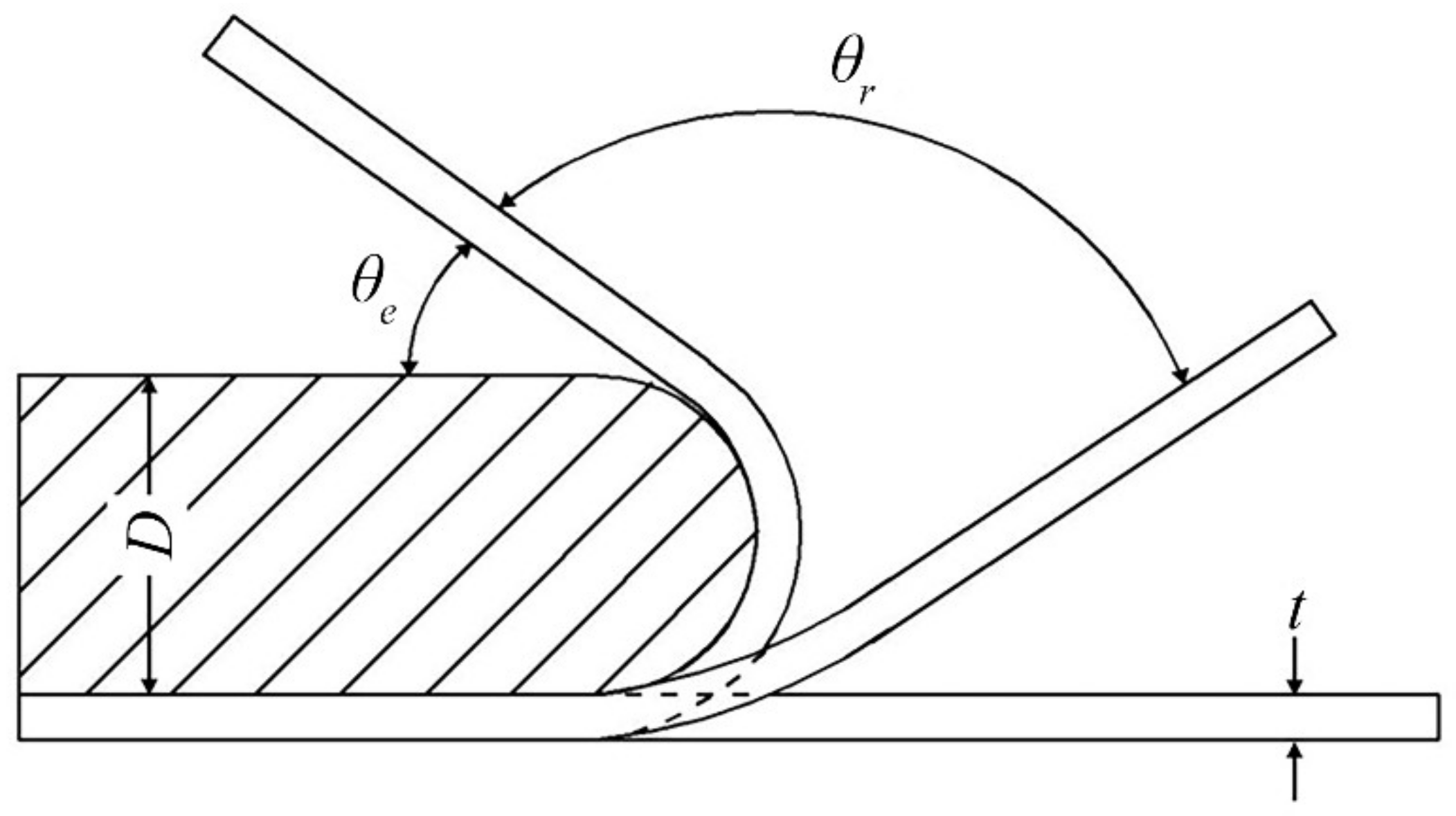
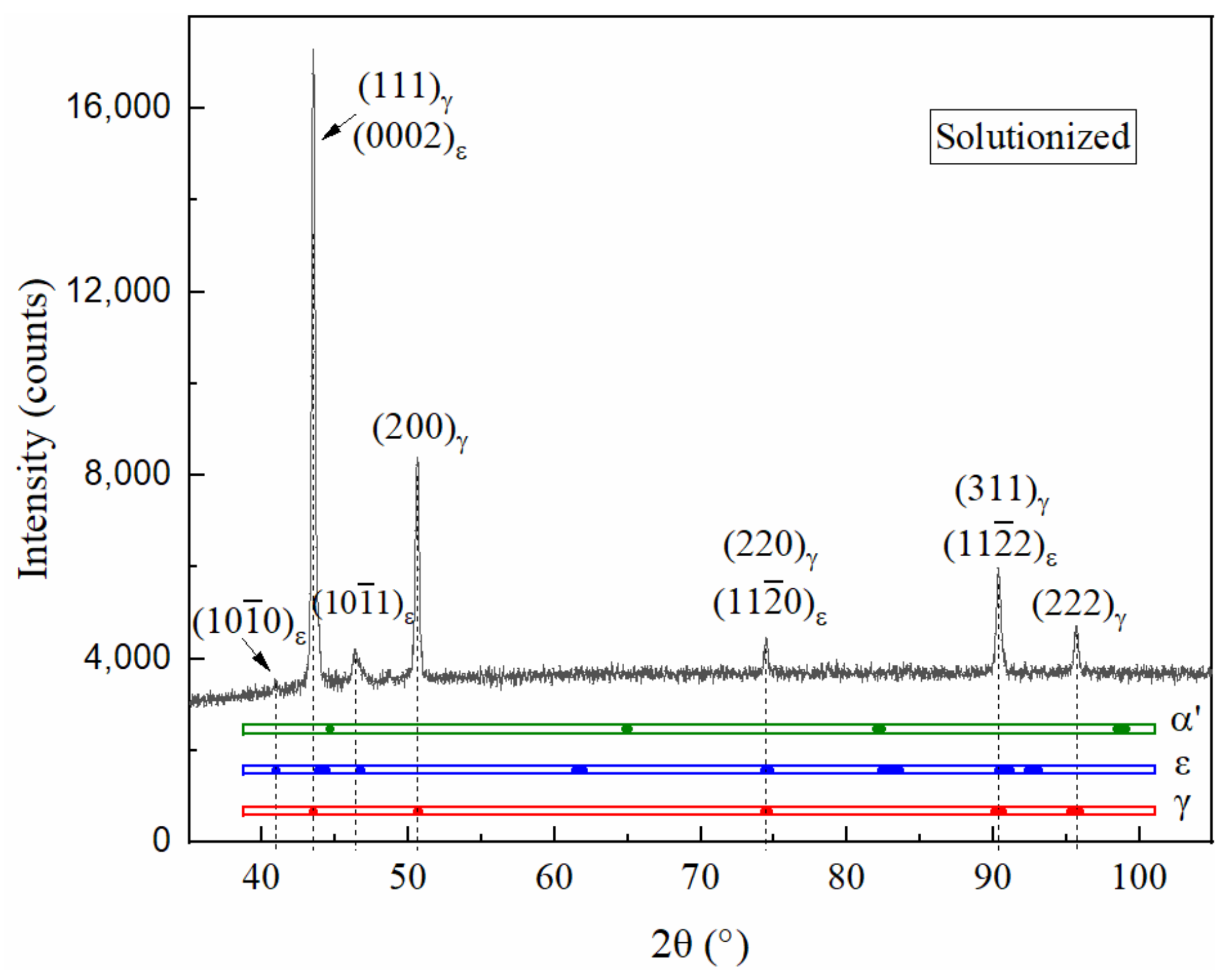
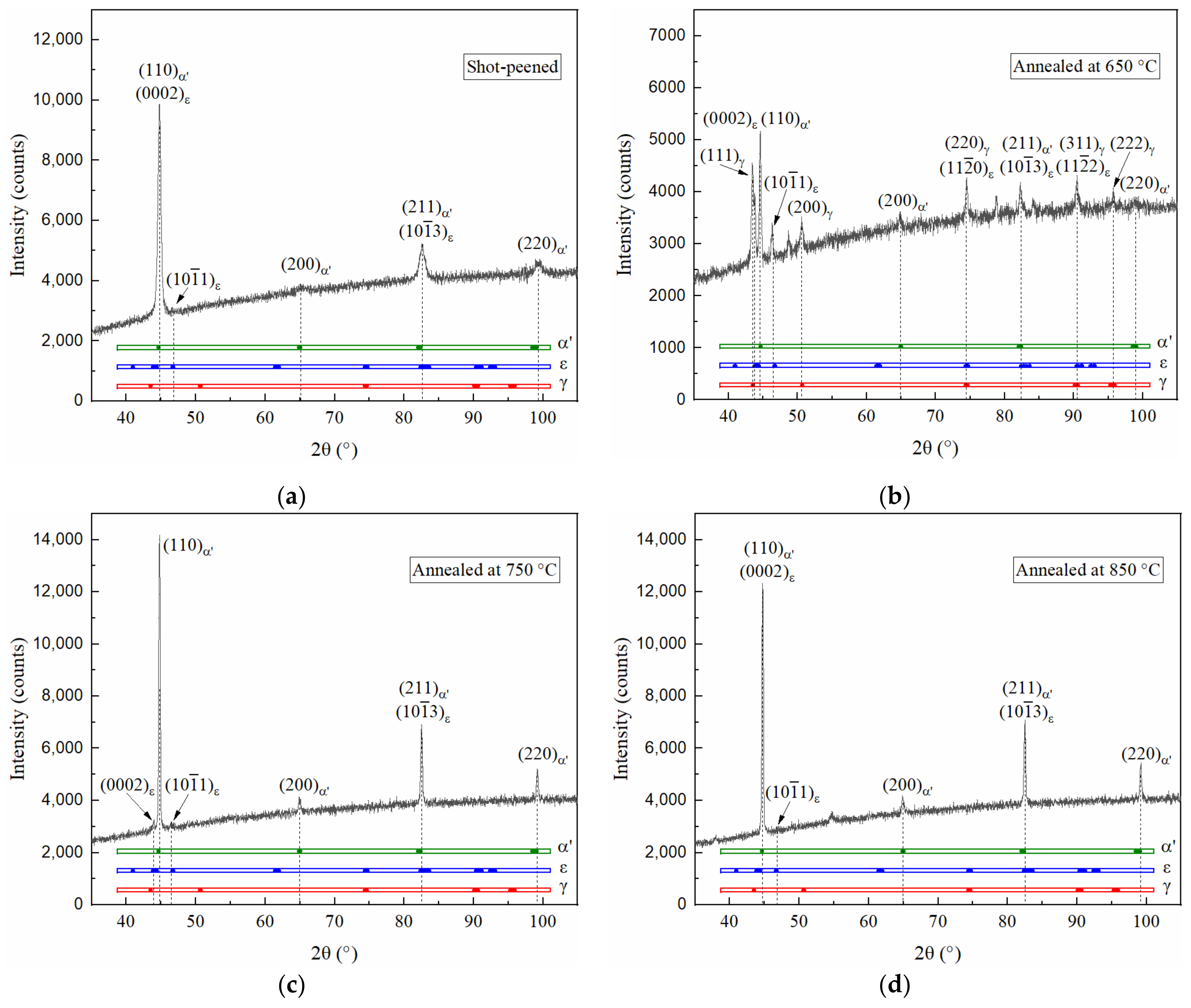
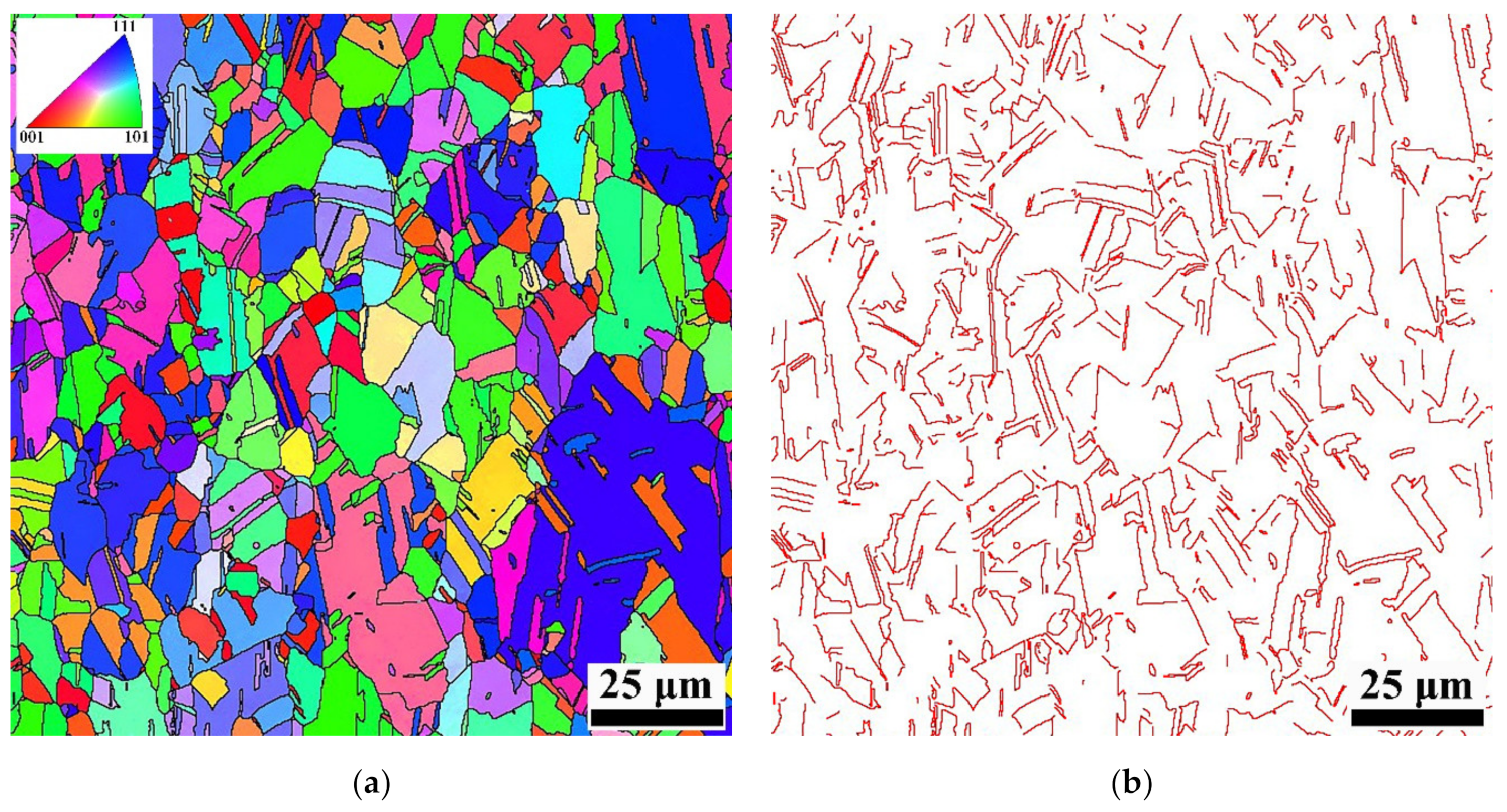
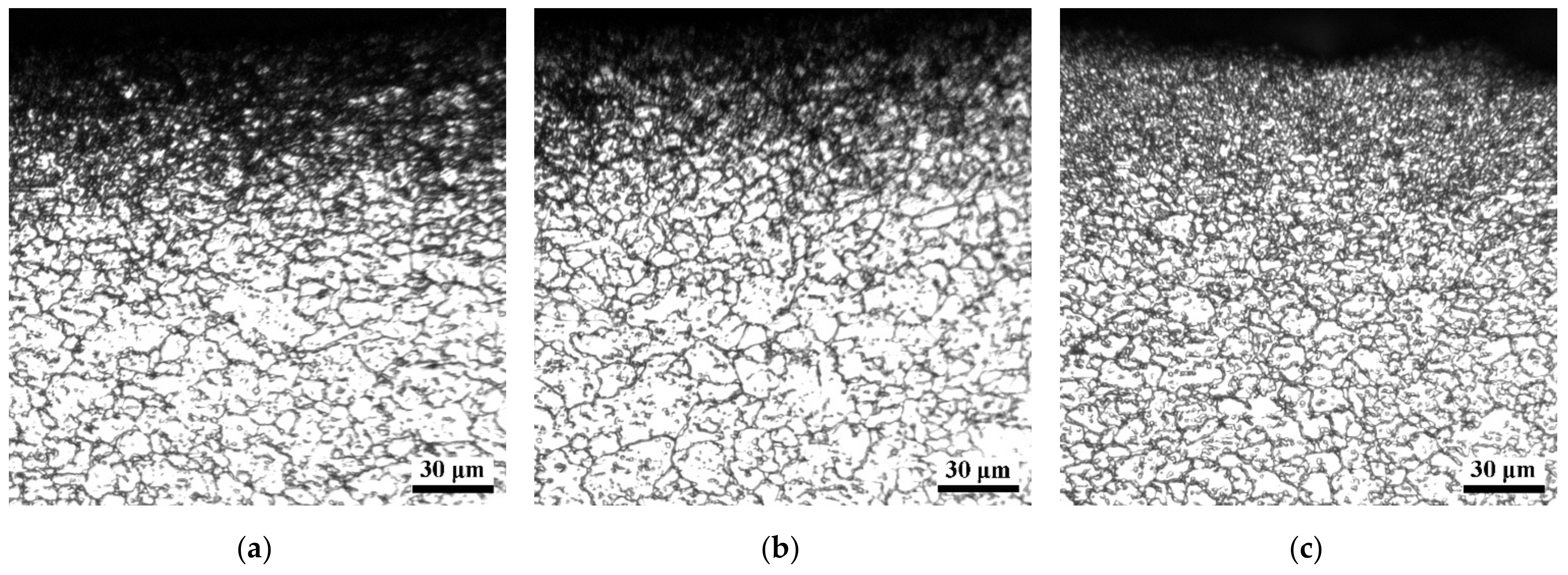
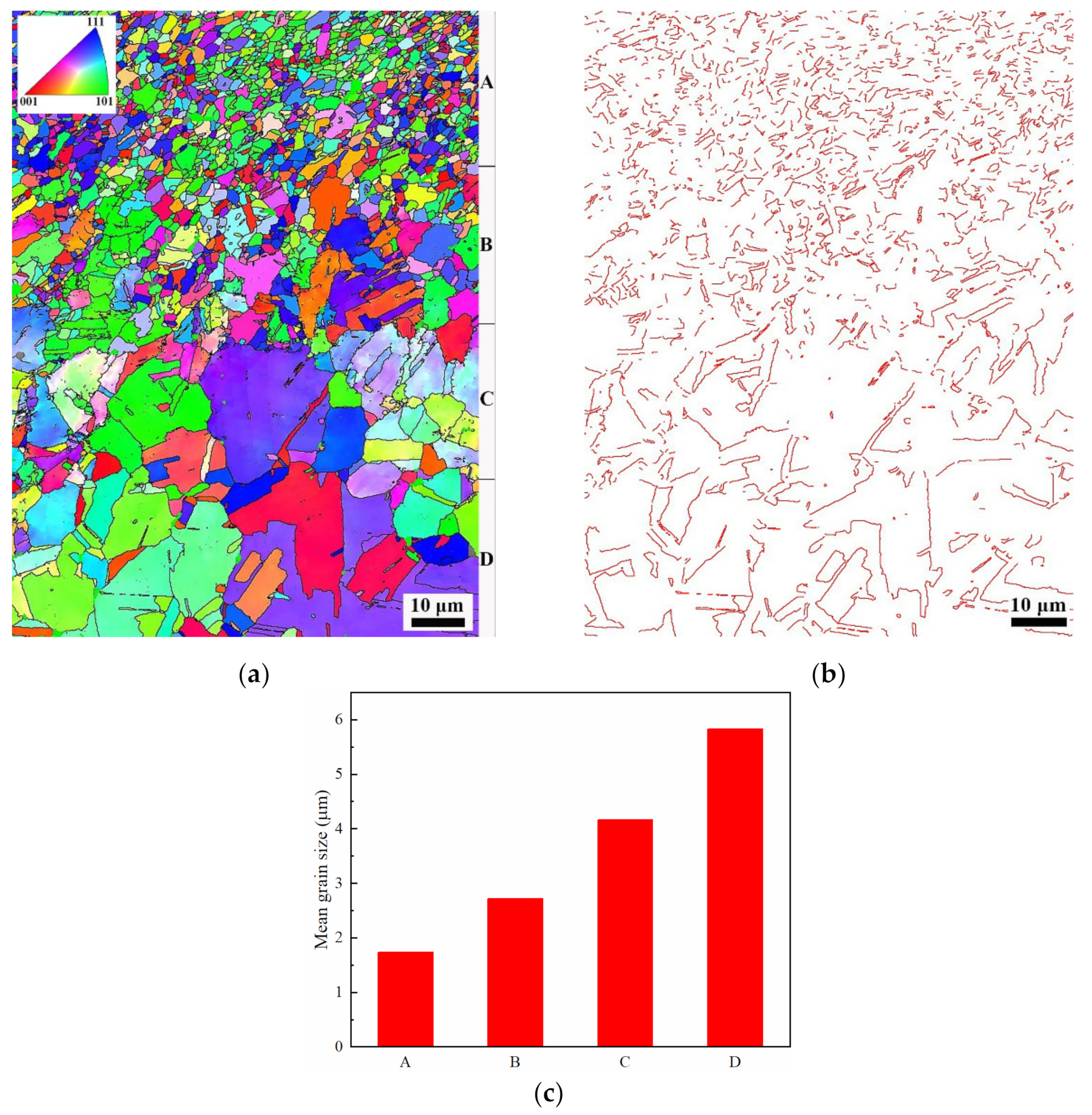

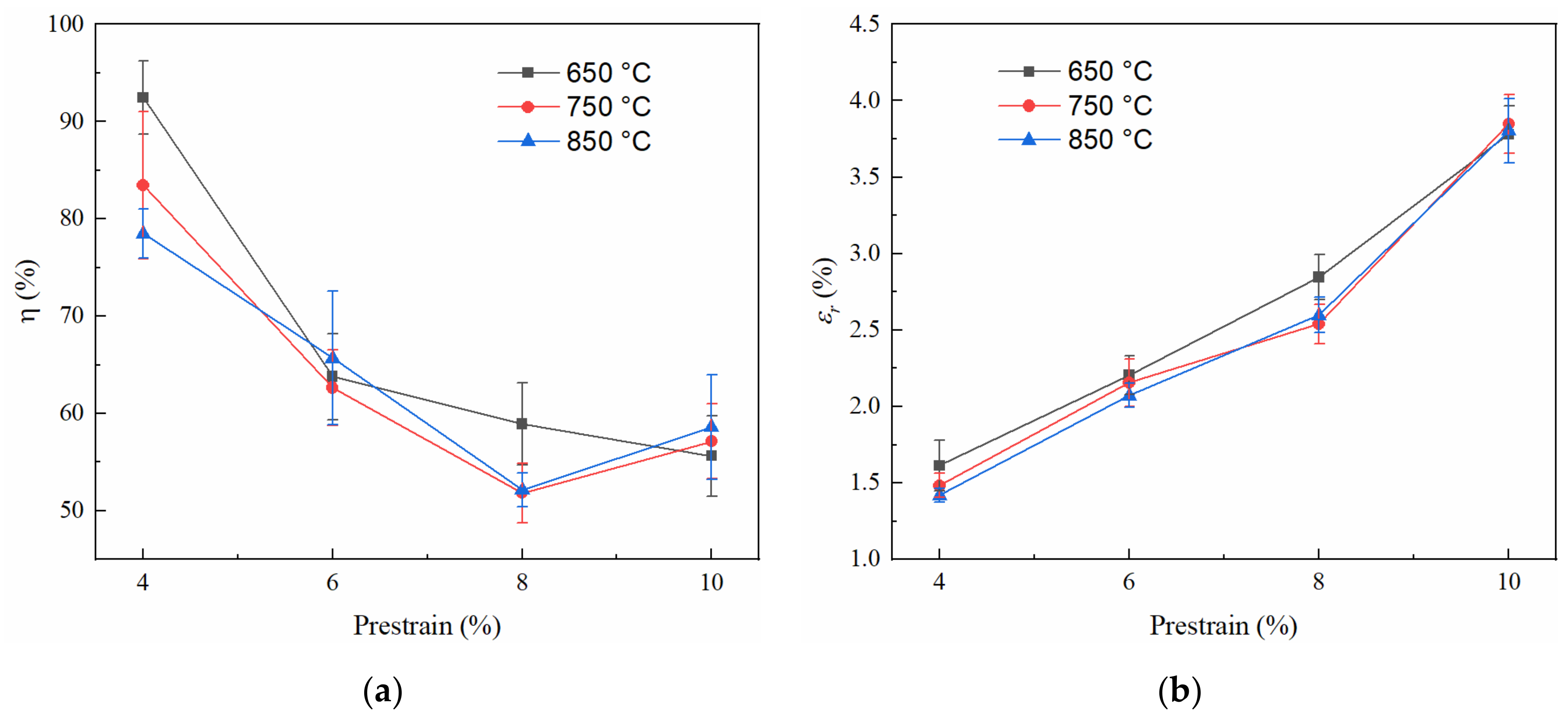
| Mn | Si | Cr | Ni | Fe |
|---|---|---|---|---|
| 24.22 | 5.50 | 9.02 | 6.06 | Balance |
| Shot Material | Shot Size (mm) | Air Pressure (MPa) | Shot Distance (mm) | Almen Intensity | Coverage Ratio (%) |
|---|---|---|---|---|---|
| Cast steel | 0.3 | 0.43 | 150 | 0.25 A | 150 |
| Phase | Crystal Structure | Lattice Parameters (Å) |
|---|---|---|
| γ-austenite | Face-centered cubic | 3.588 ≤ a ≤ 3.615 |
| ε-martensite | Hexagonal close-packed | 3.5325 ≤ a ≤ 3.5550, 4.0637 ≤ c ≤ 4.1461 |
| α′-martensite | Body-centered cubic | 2.86 ≤ a ≤ 2.88 |
Publisher’s Note: MDPI stays neutral with regard to jurisdictional claims in published maps and institutional affiliations. |
© 2022 by the authors. Licensee MDPI, Basel, Switzerland. This article is an open access article distributed under the terms and conditions of the Creative Commons Attribution (CC BY) license (https://creativecommons.org/licenses/by/4.0/).
Share and Cite
Yang, H.; Yan, W.; Deng, X.; Zhang, M.; Wang, Y. Improving the Shape Memory Effect of a Fe-Mn-Si-Cr-Ni Alloy through Shot Peening. Materials 2022, 15, 2585. https://doi.org/10.3390/ma15072585
Yang H, Yan W, Deng X, Zhang M, Wang Y. Improving the Shape Memory Effect of a Fe-Mn-Si-Cr-Ni Alloy through Shot Peening. Materials. 2022; 15(7):2585. https://doi.org/10.3390/ma15072585
Chicago/Turabian StyleYang, Huanping, Wenbin Yan, Xuyang Deng, Mengqi Zhang, and Yaomian Wang. 2022. "Improving the Shape Memory Effect of a Fe-Mn-Si-Cr-Ni Alloy through Shot Peening" Materials 15, no. 7: 2585. https://doi.org/10.3390/ma15072585
APA StyleYang, H., Yan, W., Deng, X., Zhang, M., & Wang, Y. (2022). Improving the Shape Memory Effect of a Fe-Mn-Si-Cr-Ni Alloy through Shot Peening. Materials, 15(7), 2585. https://doi.org/10.3390/ma15072585






